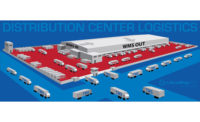Refrigerated food manufacturers continue to implement high-pressure processing (HPP) into their production lines to eliminate spoilage organisms and foodborne pathogens and extend shelf life.
In fact, HPP is a key technology making a refrigerated offering possible where historically frozen was the only option, says Jeff Barnard, president of Universal Pasteurization & Universal Cold Storage, Lincoln, Neb.
“Refrigerated food manufacturers are incorporating HPP in production because they want to reduce shrink or the amount of product that must be discarded due to spoilage,” he explains.
Consumers are also attracted to products that have been high-pressure processed because they typically support consumers’ preference for cleaner labels.
“As we have seen over the years, consumers are becoming more aware of the foods they consume,” says Kelley Battles, founder and president of HPP Foods Group, Coppell, Texas. “Food manufacturers are always investigating new ways to innovate, clean label and ultimately protect their brand. Many retailers are working with food manufacturers to bring product that has been HPPd, as they recognize the value of HPP through its reduction in shrink, the clean labeling of food products and food safety.”
Furthermore, products using HPP vs. traditional methods of preservatives and heat pasteurization have shown that they are safer, more nutrient rich and boast longer shelf lives, while maintaining the intended flavor profile, Battles adds.
And, producers of salsas, guacamole and higher-end meat products have all embraced HPP, as cleaner labels and longer shelf life can be achieved without compromising flavor, says Sarah Segel, customer service consultant at American Pasteurization Co., Wauwatosa, Wis.
“For example, right now juice is a very big product that HPP is running,” she says. “It’s because fresh fruit juices aren’t made to be cooked. Fresh fruit is supposed to taste like fresh fruit. And, so a lot of these juice companies are really starting to embrace HPP because it does not change the properities of its product.”
Producing safer products
HPP is vastly becoming a leading method in creating safer food products. In fact, many of today’s cold food processors are applying HPP because it is a post-packaging kill step that guarantees a 5-log reduction with no heat, says Jaime Nicolás-Correa, global vice president of sales and director North America for Hiperbaric, Miami. In other words, HPP eliminates any food safety threat from foodborne pathogens, particularly Listeria, E. coli and Salmonella.
Currently, Hiperbaric develops larger and faster machines that are said to enable more throughput and lower the total cost per pound, Nicolás-Correa says. For example, West Liberty Foods, LLC, West Liberty, Iowa, announced plans to install the Hiperbaric 525 HPP system in its Bolingbrook, Ill., facility. This will be the fifth unit for the company, and will support increased volumes for clean label products at a capacity that processes up to 20 million pounds per year.
HPP is not a magic bullet though, as it does not address all food safety concerns. But, it does give cold food processors another weapon in their fight to eliminate pathogens, says Patrick Ditchfield, vice president of sales for Avure Technologies, Erlanger, Ky. And, with HPP’s growth, the technology is also moving away from being a novel process to being a normal one.
“The equipment looks like and feels like other food processing machinery in a food plant,” Ditchfield says. “HPP machines can now be evaluated on throughput, cost to operate and reliability just like all other food processing equipment.”
It used to be the important measurement of a machine was the number of liters of water in the pressure vessel, adds Ditchfield.
“[But, now] a food producer does not care about this measurement,” he says. “Rather they care about the number of food packages they can produce. We ask ourselves, ‘How do we increase the amount of product our customer can run more reliably and at lower cost?’”
As such, Avure’s newest machine, the AV-60, targets high-volume product and processes 8,100 pounds per hour.
“We are investing in two areas to try to help,” Ditchfield says. “We are increasing the team of food scientists with real world experience of HPP and food manufacturing, as well as the resources our scientists need to help customers with questions such as food safety, recipe development, process documentation and control, food manufacturing and microbiology.”
HPP manufacturers are also offering equipment for all line sizes.
“Over the last year, there have been several new HPP machine models introduced with machines ranging in size from 55-525 liters that can accommodate almost any type of operation,” Battles says.
As a result, HPP Foods Group currently operates with an Avure 350L, but is investigating the 525L for maximized throughput in the same footprint, Battles says.
“The newer 525L machines offered by HPP machine manufacturers are not only faster, but also offer companies the ability to run more product through HPP,” he explains. “In addition, these new larger machines allow larger products to be HPPd due to the increased diameter of the vessels.”
Investing in HPP
Companies can still take their product to market using HPP technology without making a large capital investment through the use of toll processors. That’s why Universal Pasteurization & Universal Cold Storage continues to invest in new locations and additional machines.
“At each location and across our network, Universal provides redundancy in equipment, cold storage capabilities and distribution services,” Barnard says. “We make it not only possible, but also easy for producers to provide their customers with the benefits of HPP.”
Meanwhile, toll proccessor American Pasteurization operates four machines in Milwaukee and two at its Sacramento, Calif., location. Because HPP equipment can be expensive and high maintenance, running and maintaining it is a business in and of itself, Segel says.
“Companies are trying to figure out what other product lines that they have that they are currently using lots of preservatives in or using heat pasteurization in where they don’t want to be and if they can transfer them over into HPP,” Segel says. “The future for HPP techology is incorporating a more and more diverse pool of products that work well with HPP that can really benefit from the technology.”
With more locations, the HPP landscape has afforded for the rapid advancement and distribution of products that otherwise would not have the ability to grow or be developed, Battles adds. Also, there have been a lot of ancillary services that come up around HPP, like product innovation, packaging development, distribution and logistics efficiencies, he says.
Applying pulsed electric field technology to the HPP world
Pulsed electric field (PEF), another techology that elminiates microorganisms, but leaves compounds like vitamins and proteins unaffected, also is expanding in usage. PEF is continuous processing, while HPP is batch processing typically done in a product’s final pack, says Mark de Boevere, managing director for Pulsemaster BV, Bladel, The Netherlands.
“When you talk about liquid products, for example fresh juices or soups, PEF can be a very good alternative because it is less labor involved,” he says.
As a technology, PEF can be applied in many applications as a processing tool. For example, after PEF treatment of raw potatoes, one can tie a raw French fry into a knot after cutting.
“You are drilling holes in the membranes of the cells of the item, and this will give the potato process all kinds of advantages, such as they don’t need a pre-heater, better cutting capabilities, improved suger leaching and less fat into the French fry,” says de Boevere.
Bulk pasteurization
For its part, Radio Frequency Co.’s new Macrowave pasteurization systems are ideal for batch or conveyorized applications for bagged or bulk product such as ready-to-eat products, frozen pizzas, etc., according to Tim Clark, president and CEO of the Millis, Mass., company.
“In a Macrowave heating system, an RF generator creates an alternating electric field between two electrodes,” he adds. “The material to be treated is conveyed through an electrode array where this alternating energy causes polar molecules in the material to continuously re-orient themselves to face opposite poles, much like the way bar magnets behave in an alternating magnetic field. The friction resulting from molecular movement causes the material to heat both rapidly and uniformly throughout its entire mass.”
These Macrowave pasteurization systems operate at 40MHz where the depth of penetration and uniformity of heating are optimized, thereby providing an extra kill step to ensure food safety.
Addressing HPP concerns
One concern for cold food processors utilizing HPP is the packaging of the product to be HPP processed, says Guy Giordano, president and CEO of Vincent Giordano Corp., Philadelphia.
“HPP technologies need to be more proactive in sourcing packaging solutions that work with HPP,” he says. “I believe more regional toll processing centers will be opening around the country to accommodate smaller food processors along with large food processors installing in-house systems.”
Likewise, the use of HPP continues to steadily grow.
“Ten years ago, the question surrounding HPP was, ‘What is this technology?’” says Battles. “Five years ago, the question changed to, ‘Can I afford it?’ Now, it is normal, not novel, technology, so the questions are changing to normal food manufacturing questions. The benefits of HPP are so tremendous that entrepreneurial companies are entering the market space of HPP, and within months, are national brands. With all of the chemicals used in processed foods, HPP allows the companies to have offerings that consumers are looking for. HPP has given all sizes of companies the ability to be creative and offer products that are safer, longer lasting and that carry a label without preservatives.”
Despite the cost and maintenance of an HPP machine, refrigerated food manufacturers continue to implement HPP machines into their operations to help produce safer and longer-lasting food.







